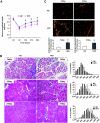PTEN inhibition improves muscle regeneration in mice fed a high-fat diet
- PMID: 20200318
- PMCID: PMC2874691
- DOI: 10.2337/db09-1155
PTEN inhibition improves muscle regeneration in mice fed a high-fat diet
Abstract
Objective: Mechanisms impairing wound healing in diabetes are poorly understood. To identify mechanisms, we induced insulin resistance by chronically feeding mice a high-fat diet (HFD). We also examined the regulation of phosphatidylinositol 3,4,5-trisphosphate (PIP(3)) during muscle regeneration because augmented IGF-1 signaling can improve muscle regeneration.
Research design and methods: Muscle regeneration was induced by cardiotoxin injury, and we evaluated satellite cell activation and muscle maturation in HFD-fed mice. We also measured PIP(3) and the enzymes regulating its level, IRS-1-associated phosphatidylinositol 3-kinase (PI3K) and PTEN. Using primary cultures of muscle, we examined how fatty acids affect PTEN expression and how PTEN knockout influences muscle growth. Mice with muscle-specific PTEN knockout were used to examine how the HFD changes muscle regeneration.
Results: The HFD raised circulating fatty acids and impaired the growth of regenerating myofibers while delaying myofiber maturation and increasing collagen deposition. These changes were independent of impaired proliferation of muscle progenitor or satellite cells but were principally related to increased expression of PTEN, which reduced PIP(3) in muscle. In cultured muscle cells, palmitate directly stimulated PTEN expression and reduced cell growth. Knocking out PTEN restored cell growth. In mice, muscle-specific PTEN knockout improved the defects in muscle repair induced by HFD.
Conclusions: Insulin resistance impairs muscle regeneration by preventing myofiber maturation. The mechanism involves fatty acid-stimulated PTEN expression, which lowers muscle PIP(3). If similar pathways occur in diabetic patients, therapeutic strategies directed at improving the repair of damaged muscle could include suppression of PTEN activity.
Figures






Similar articles
-
PTEN expression contributes to the regulation of muscle protein degradation in diabetes.Diabetes. 2007 Oct;56(10):2449-56. doi: 10.2337/db06-1731. Epub 2007 Jul 10. Diabetes. 2007. PMID: 17623817
-
Paraoxonase1 (PON1) reduces insulin resistance in mice fed a high-fat diet, and promotes GLUT4 overexpression in myocytes, via the IRS-1/Akt pathway.Atherosclerosis. 2013 Jul;229(1):71-8. doi: 10.1016/j.atherosclerosis.2013.03.028. Epub 2013 Apr 10. Atherosclerosis. 2013. PMID: 23639858
-
Pancreas-specific Pten deficiency causes partial resistance to diabetes and elevated hepatic AKT signaling.Cell Res. 2009 Jun;19(6):710-9. doi: 10.1038/cr.2009.42. Cell Res. 2009. PMID: 19365404
-
Regulation of muscle plasticity and trophism by fatty acids: A short review.Rev Assoc Med Bras (1992). 2017 Feb;63(2):148-155. doi: 10.1590/1806-9282.63.02.148. Rev Assoc Med Bras (1992). 2017. PMID: 28355376 Review.
-
Roles of phosphatase and tensin homolog in skeletal muscle.J Cell Physiol. 2019 Apr;234(4):3192-3196. doi: 10.1002/jcp.26820. Epub 2018 Nov 23. J Cell Physiol. 2019. PMID: 30471096 Review.
Cited by
-
MyomiRs as Markers of Insulin Resistance and Decreased Myogenesis in Skeletal Muscle of Diet-Induced Obese Mice.Front Endocrinol (Lausanne). 2016 Jun 27;7:76. doi: 10.3389/fendo.2016.00076. eCollection 2016. Front Endocrinol (Lausanne). 2016. PMID: 27445979 Free PMC article.
-
An Overview of Murine High Fat Diet as a Model for Type 2 Diabetes Mellitus.J Diabetes Res. 2016;2016:2902351. doi: 10.1155/2016/2902351. Epub 2016 Jul 31. J Diabetes Res. 2016. PMID: 27547764 Free PMC article. Review.
-
Differences in Circulating microRNAs between Grazing and Grain-Fed Wagyu Cattle Are Associated with Altered Expression of Intramuscular microRNA, the Potential Target PTEN, and Lipogenic Genes.PLoS One. 2016 Sep 9;11(9):e0162496. doi: 10.1371/journal.pone.0162496. eCollection 2016. PLoS One. 2016. PMID: 27611783 Free PMC article.
-
The functional consequences of age-related changes in microRNA expression in skeletal muscle.Biogerontology. 2016 Jun;17(3):641-54. doi: 10.1007/s10522-016-9638-8. Epub 2016 Feb 27. Biogerontology. 2016. PMID: 26922183 Free PMC article.
-
Investigating the Effects of Diet-Induced Prediabetes on Skeletal Muscle Strength in Male Sprague Dawley Rats.Int J Mol Sci. 2024 Apr 6;25(7):4076. doi: 10.3390/ijms25074076. Int J Mol Sci. 2024. PMID: 38612885 Free PMC article.
References
-
- Hirsch T, Spielmann M, Velander P, Zuhaili B, Bleiziffer O, Fossum M, Steinstraesser L, Yao F, Eriksson E: Insulin-like growth factor-1 gene therapy and cell transplantation in diabetic wounds. J Gene Med 2008; 10: 1247–1252 - PubMed
-
- Vignaud A, Ramond F, Hourde C, Keller A, Butler-Browne G, Ferry A: Diabetes provides an unfavorable environment for muscle mass and function after muscle injury in mice. Pathobiology 2007; 74: 291–300 - PubMed
-
- Shortreed K, Johnston A, Hawke TJ: Satellite cells and muscle repair. In Skeletal Muscle Damage and Repair 1st ed Tiidus PM: Ed. Champaign, IL, Human Kinetics, 2008, p. 77–88
-
- Grefte S, Kuijpers-Jagtman AM, Torensma R, Von den Hoff JW: Skeletal muscle development and regeneration. Stem Cells Dev 2007; 16: 857–868 - PubMed
-
- Charge SB, Rudnicki MA: Cellular and molecular regulation of muscle regeneration. Physiol Rev 2004; 84: 209–238 - PubMed
Publication types
MeSH terms
Substances
Grants and funding
LinkOut - more resources
Full Text Sources
Medical
Molecular Biology Databases
Research Materials
Miscellaneous

